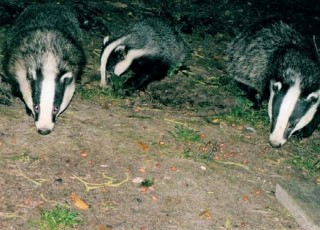BADGERS – LOVE’EM, OR HATE’EM?
Despite the fact that very few people in this county have ever seen one – road deaths excluded – it is hard to think of an animal that currently arouses such strong feelings as the badger. On one side are the many wildlife lovers who see poor ‘Brock’ as a much persecuted and maligned creature. On the other side are farmers whose livelihoods are threatened by the increasing incidence of TB, and people whose lands or lawns are home to the badgers’ favourite diet of the earthworm.
Prior to 1908 badgers had precious few friends. Badger baiting and badger digging were still commonplace activities, and keepers trapped or shot any creature that they considered a threat to their precious game birds. That year, however, saw the first publication of ‘Wind in The Willows’ by my namesake Kenneth Grahame. Since then children and adults of all ages have revelled in the timeless adventures of Mole, Ratty (a water vole), Toad and Badger, the last named destined to become the emblem of the wildlife trusts.

Enter now Lord ‘Boofy’ Arran, whose wife (a cousin of mine by marriage) at one time held the world land speed record. ‘Boofy’ was the prime mover of two bills, both of which were finally enacted by Parliament. The first was the 1967 Sexual Offences Act, that liberalised homosexuality, while the second was the 1973 Badgers Act, which finally gave Mr. Badger legal protection from persecution.
(Arran used to delight in telling his friends that his sole parliamentary contribution consisted of two acts, one of which prevented people badgering buggers, while the other prevented people buggering badgers).
This legal protection cannot in itself explain the phenomenal population explosion of these animals that has occurred in many parts of Britain, especially in the last twenty or thirty years. One factor, however, is undoubtedly the scientifically accepted fact that a species can multiply or decrease in direct correlation to its food supply. Apart from the huge increase of chemical fertilizers, pig-, cow-, and horse-muck have never before been so liberally applied to the land, be it farm or garden. This has brought with it a massive increase in the earthworm population, of which a single badger can consume over two hundred in a night.

Speaking personally, I must confess to having a love-hate relationship with these creatures, of which we probably have around thirty on this reserve. Many people, young and old, have enjoyed magical summer evenings, sitting quietly with me and watching the delightful antics of our badgers and their cubs. When, as is often the case, I go up there on my own, the cubs are even more confiding. Last year I nearly lost my shoe one evening. I had put a dollop of honey on it and one cub wasn’t content to just lick it off! On occasions when they dig up the lawn, however, my language becomes unprintable.
Iain Grahame
Once again Iain has written an interesting slant on a controversial subject. There is no doubt that the badger population is, in my view, getting too great. A couple of years ago I could take you to over thirty setts within half a mile of my house. Why do the public love them so, when they only come out at night, and they never see them? Their only predator is a motor vehicle.

